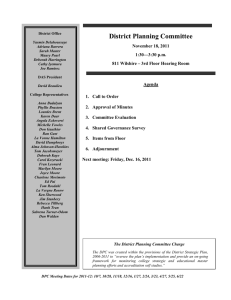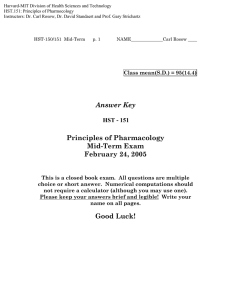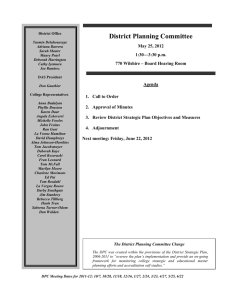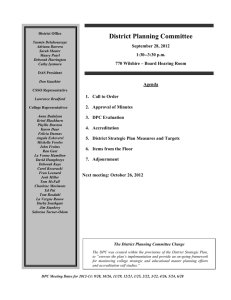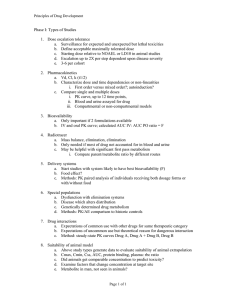Document 13626110
advertisement
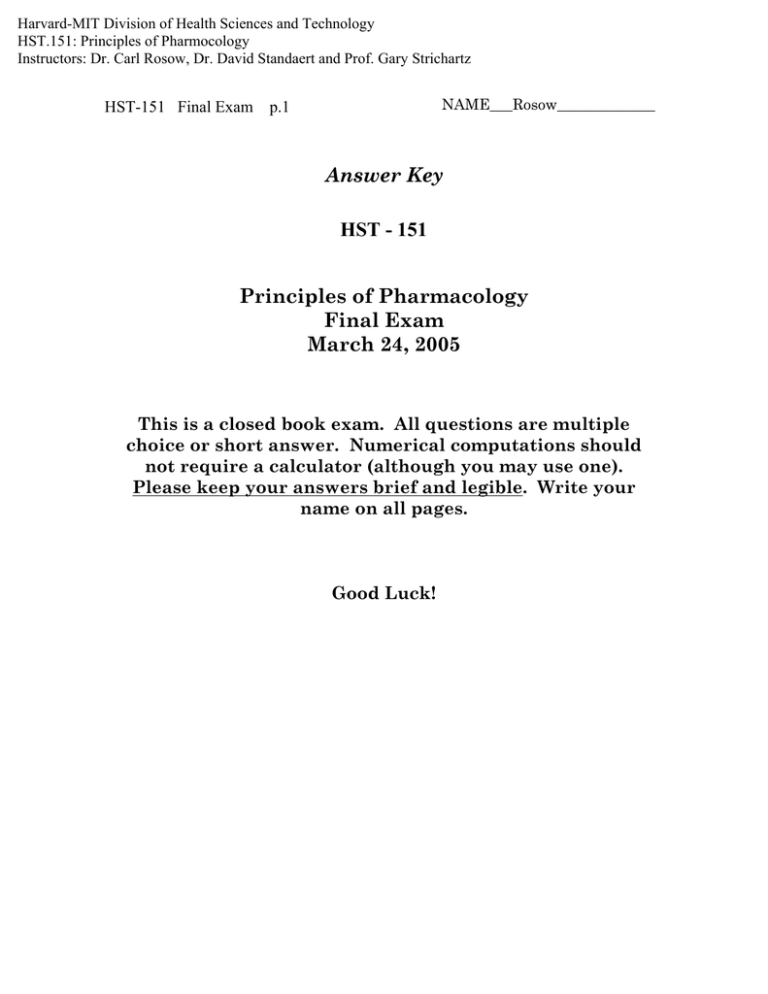
Harvard-MIT Division of Health Sciences and Technology HST.151: Principles of Pharmocology Instructors: Dr. Carl Rosow, Dr. David Standaert and Prof. Gary Strichartz HST-151 Final Exam NAME___Rosow_____________ p.1 Answer Key HST - 151 Principles of Pharmacology Final Exam March 24, 2005 This is a closed book exam. All questions are multiple choice or short answer. Numerical computations should not require a calculator (although you may use one). Please keep your answers brief and legible. Write your name on all pages. Good Luck! HST-151 Final Exam p. 2 NAME___Rosow_____________ 1. The graph below shows the results of experiments in which contraction of a segment of guinea pig ileum was used to test the effects of fentanyl and an opioid peptide, D-Ala, D-Leu Enkephalin (DADL). The concentration-response curves for fentanyl or DADL alone were identical. Each was then tested in the presence of 10-7M drug X. What is the nature of the interaction between Fentanyl or DADL and X? [3] X is a competitive antagonist of both fentanyl and DADL What is the Ka in each case? What does this tell you about the two drugs? [8] [A] EC50 with antag −1= EC50 without antag KA 1 1 − 7 = 10 M × = 10− 7 M × 1 = 2.04 × 10− 9 M K A ( fent ) = [A ] × -6 EC50 with antag 5x10 49 − 1 EC50 without antag − 1 -7 10 1 = 10 − 7 M × 1 = 2.5 × 10 − 8 M K A ( DADL ) = 10 − 7 M × -7 5x10 4 − 1 -7 10 Different KA for X = different receptors for Fentanyl and DADL HST-151 Final Exam p. 3 NAME___Rosow_____________ 2. You are asked to consult for a company developing a new antiepileptic drug. It suppresses seizure activity in mice, and it has the following in vitro properties: Octanol:Water = 1000 GABA kd = 10-10 M 50% protein bound Hydrolyzed to inactive products by plasma cholinesterase. Using each of these pieces of information, make a prediction about the eventual pharmacological profile of this compound (explain). [8] Numerous answers possible. Here are a few: Highly fat soluble – Drug probably has large Vd, gets into brain, good tissue penetration; probably well-absorbed through skin and mucous membranes High affinity for GABA receptor – Potent CNS depressant effects; may be fairly selective. Coupled with lipid solubility, might be good drug for use in a transdermal patch. Moderate to low protein binding – Unlikely to have drug-drug interactions due to binding displacement. Not a large reservoir of drug in blood. Hydrolyzed by pseudocholinesterase – Clearance may be rapid, probably unaffected by renal or hepatic dysfunction. Probable genetic variability in drug clearance due to abnormal pseudocholinesterase. Drug action prolonged by pseudoChE inhibitors (neostigmine, echothiophate). 3. Which of the following acts primarily at ligand gated ion channels? (Check all that apply) [5] a. b. c. d. e. Hemicholinium l-Dopa Phenylephrine Midazolam***** Thiopental***** HST-151 Final Exam p. 4 NAME___Rosow_____________ 4. S is an inhaled anesthetic with a blood-gas solubility coefficient that is only ½ that of isoflurane. What implications does this have for the clinical effects of S? [5] Anesthetic effect is proportional to partial pressure, not dissolved gas. Low blood-gas solubility means faster rise and fall of end-tidal partial pressure when inspired concentration is changed. Clinically, this means faster induction and emergence. Blood gas solubility does not determine potency. 5. The following graph shows the relationship between the daily dose of phenytoin and the steady state concentration. What is the explanation for this? What implication does it have for patient care? [6] The drug obeys dose-dependent (saturation) kinetics rather than first order. Half-life is lengthening as dose is raised. Non-linear kinetics means that a small dosage increment can potentially cause a very large increase in phenytoin concentration and produce toxicity. This is why plasma concentrations are often monitored during titration. HST-151 Final Exam p. 5 NAME___Rosow_____________ 6. Piroxicam is an NSAID with a terminal half-life of ~60 hr. Other than the frequency of dosing, how does this property affect its clinical use? [5] Slow onset and slow clearance. In chronic dosing, steady state will not be achieved for almost two weeks. This means that a loading dose would be needed for rapid effects, and manifestations of toxicity could be delayed. This drug is best suited to chronic dosing rather than acute pain. 7. Which of the following immunosuppressant drugs inhibits calcineurin? (check all that apply) [5] a. b. c. d. e. Prednisone Cyclosporine***** Azathioprine Sirolimus Tacrolimus***** 8. How do the following combinations change efficacy or toxicity? [12] Imipenem – Cilastatin Imipenem is hydrolyzed by peptidases in renal tubule to produce a nephrotoxic metabolite. Cilastatin specifically inhibits these peptidases. l-Dopa – Entacapone Entacapone inhibits metabolism of l-DOPA to 3 methoxydopa in systemic circulation, so more is available for transport into CNS. Increased duration, less “wearing-off.” Meperidine – Pargyline The “Libby Zion” interaction. The opioid, meperidine, and MAOI can cause severe CNS excitation with fever – sometimes coma and death. Methotrexate – Leucovorin High-dose MTX kills rapidly dividing leukemic cells by inhibiting dihydrofolate reductase. “Rescue” with leucovorin (folinic acid) can salvage many normal cells. HST-151 Final Exam p. 6 NAME___Rosow_____________ 9. Terfenadine is off the market and replaced with its metabolite, fexofenadine. What was the reasoning behind this move? [5] All the therapeutic antihistaminic effects came from the metabolite, but the toxicity came from the parent drug. Terfenadine inhibited Ikr and caused torsades de pointes, especially if metabolism was inhibited by another drug. The metabolite is now sold as Allegra®. 10. How can an antidysrhythmic drug promote a re-entrant dysrhythmia? [5] A reentrant dysrthymia occurs when a local unidirectional conduction block sets up an electrical loop, whereby an electric impulse returns to restimulate the same area of myocardium. In order to sustain restimulation, the returning impulse must be slow enough to meet non-refractory tissue. The following relationship must be present: Path length X conduction velocity > refractory period Antidysrhythmics can start or sustain such rhythms by slowing conduction velocity. 11. Patients with metastatic ovarian carcinoma usually undergo surgical “debulking” prior to chemotherapy, despite the fact that some tumor is left behind. What is the rationale for this? [6] By decreasing the visible tumor burden, there are only small or microscopic tumor foci. A small tumor size means that there will be fewer cells to kill, and those cells will have a higher growth fraction (cf., Gompertzian growth characteristics). This will increase sensitivity to cell cycle-active chemotherapeutic agents. HST-151 Final Exam p. 7 NAME___Rosow_____________ 12. The medicinal chemistry department of your company has come up with a statin that is 10x more potent than atorvastatin and twice as efficacious. Does this sound like a promising drug for development? Explain [5] Probably not, since lack of potency and efficacy aren’t the major drawbacks for existing statins. Too much cholesterol lowering can be toxic. Cerivastatin was a highly potent and efficacious statin, but it caused extreme reductions in cholesterol and proved to be toxic. There are similar worries for other highly efficacious therapies like rosuvastatin and the simvastatin/ezetimibe combination. 13. Which of the following decreases peripheral vascular resistance during chronic administration? (Check all that apply) [5] a. b. c. d. e. Hydrochlorothiazide***** Nifedipine***** Lisinopril***** Prazosin***** Labetalol***** 14. Which of the following is a competitive antagonist? (Check all that apply) [5] a. b. c. d. e. Doxorubicin Omeprazole Naproxen***** Sumatriptan Phenoxybenzamine 15. What is the appropriate role for positive inotropic agents in the treatment of congestive heart failure? [6] Digoxin, milrinone, dobutamine, etc. are all used to stabilize patients with acute decompensated CHF and relieve symptoms. They may be used until the precipitating factor is corrected (excessive salt load) or until definitive therapy is instituted (e.g., cardiac transplant). If used chronically, they confer no mortality benefit, and some may actually increase mortality. HST-151 Final Exam p. 8 NAME___Rosow_____________ 16. How does inhaled nitric oxide improve oxygenation in babies with persistent pulmonary hypertension? Could the same effect be achieved with intravenous sodium nitroprusside? [6] Increased pulmonary vascular resistance (PVR) causes hypoxemia by producing right to left shunting through the ductus and the foramen ovale. Inhaled NO decreases PVR by activating guanylate cyclase and relaxing endothelial smooth muscle. Because it only does this in ventilated areas, it also improves V/Q matching. NO is rapidly scavenged by hemoglobin so it does not cause systemic vasodilation. Sodium nitroprusside donates NO, but it does so non-selectively. PVR decreases, but so does systemic vascular resistance, therefore hypotension results. Dilation of pulmonary vessels occurs in nonventilated areas, so V/Q matching is worsened. 17. What is the theoretical benefit to giving gentamicin as a single daily dose? [5] Bacteriocidal effects of gentamicin depend upon achieving an adequate peak concentration at regular intervals. The nephrotoxicity and ototoxicity are increased when trough levels remain high between peaks. Giving the entire daily dose at once maximizes the peak and minimizes the trough levels. 18. Why are normal doses of methotrexate or penicillin not effective for tumors/infections in the central nervous system? [5] Both drugs are able to enter the CNS, but both are rapidly pumped out by active transport mechanisms in the choroid plexus. Methotrexate is a substrate for the p-glycoprotein pump (MDR) that is blocked by verapamil. Penicillin is a substrate for the organic anion transporter (MRP1-6) that is blocked by probenecid. HST-151 Final Exam p. 9 NAME___Rosow_____________ 19. Cyclophosphamide is used for both immunosuppression and cancer chemotherapy. Describe two ways that its use and therapeutic effects differ in these two situations. [6] Cyclophosphamide is an alkylating agent that is cell cycle-active. For immunosuppression, it is given in a low dose, continuously to suppress ongoing cellular responses to antigenic stimuli. In chemotherapy, a high dose is given to kill tumor cells, and then time is allowed for immune function and normal cells to recover. Its selectivity as an immunosuppressant is based on the fact that the antigen stimulates only relevant cellular clones to divide rapidly, and they are therefore most sensitive. Its selectivity for tumors depends upon the innate growth rate of the tumor cells relative to normal cells. Immunosuppression can often be timed for maximal cellular activity when an antigen is presented (i.e., at time of transplant). This is generally not possible with tumors. 20. Is there any theoretical benefit to using ropinerole rather than ldopa to treat Parkinson’s Disease? [5] Ropinerole is a direct dopamine agonist at d2/d3 receptors. There is some evidence that use of a direct agonist rather than l-DOPA causes less wearing off and dyskinesias, and it may (possibly) cause a slower progression of the disease. 21. A cancer patient is receiving a sustained-release morphine preparation for several months. Does morphine 6-glucuronide likely play a role in the analgesic effects? [5] M6G is an active metabolite, but its slow entry and exit from the CNS make it unlikely to have much effect after a single dose. Chronically, however, it is likely to accumulate in the CNS and may actually play a dominant role in morphine analgesia. 22. A cancer patient requires very high doses of morphine for pain. Is she at increased risk for opioid side-effects? Explain. [5] Not for respiratory depression and nausea because tolerance develops rapidly. Severe constipation is a real risk of therapy. HST-151 Final Exam p. 10 NAME___Rosow_____________ ***Mind Games*** We recently ran across this breaking medical news story in The Onion (www.theonion.com) : Image removed for copyright reasons. Please see: "Report: Aspirin Taken Daily With Bottle Of Bourbon Reduces Awareness of Heart Attacks." The Onion 33, no. 22 (June 10, 1998). Inspired to investigate this property of alcohol, an HST student volunteered to participate in a dose-response experiment (after giving written informed consent). When we administered 4 oz of 80proof bourbon he demonstrated impaired “awareness.” The effect was undetectable by 1 hr, at which time his blood alcohol concentration had dropped from 105 to 55 mg/dL Given this information, can you predict the peak blood alcohol and the duration of effect if we repeated the experiment with 16 oz of bourbon? (Do not try this at home.) [6] If 4 oz gives 105 mg/dL, then rapid consumption of 16 oz. gives a peak blood alcohol concentration of 420 mg/dL. That is sufficient to produce coma in nontolerant individuals! (A really bad idea…) Alcohol metabolism is zero-order over the entire “clinical” range, so we know the student’s maximal clearance is about 50 mg/dL/hr. We predict the effect of 16 oz. will disappear when the concentration drops to 55 mg/dL (about 14 oz have been metabolized): 420 mg/dL − 55 mg/dL = 7.3 hr 50 mg/dL/hr

